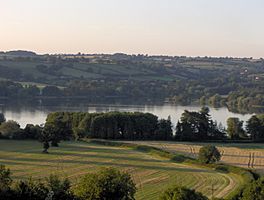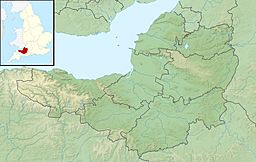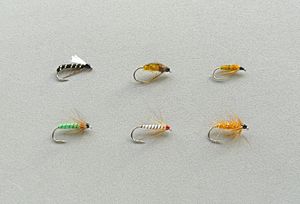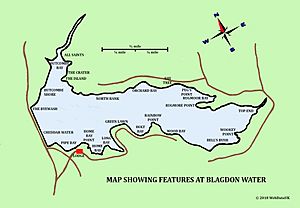Blagdon Lake facts for kids
Quick facts for kids Blagdon Lake |
|
|---|---|
 |
|
| Location | Blagdon, Somerset |
| Coordinates | 51°20′04″N 2°41′51″W / 51.33431°N 2.69757°W |
| Type | reservoir |
| Primary inflows | River Yeo |
| Primary outflows | River Yeo |
| Catchment area | 2,144 hectares (5,300 acres) |
| Basin countries | United Kingdom |
| Surface area | 440 acres (180 ha) |
| Average depth | 14 ft (4.3 m) |
| Max. depth | 42 ft (13 m) |
| Water volume | 8,456 million litres (6,855 acre⋅ft) |
Blagdon Lake is a large lake in Somerset, England. It sits near the village of Blagdon, about 10 miles south of Bristol. This lake isn't natural; it's a reservoir, which means it was built by people to store water.
The lake was created by a company called Bristol Water. They started building it in 1898 and finished in 1905. To make the lake, they built a big wall, called a dam, across the River Yeo. A special railway, the Wrington Vale Light Railway, was built just to bring materials for the lake's construction.
Blagdon Lake is still very important today. It provides billions of liters of clean drinking water every year for people in Bristol and nearby areas. It's also a popular place for fishing and is home to many different plants and animals. Because of its special wildlife, it's known as a Site of Special Scientific Interest.
Contents
About the Lake
The lake was first called the Yeo Reservoir. It covers a huge area, about 440 acres (which is like 330 football fields!). The River Yeo starts in a village called Compton Martin. It then flows into Blagdon Lake. After leaving the lake, the river continues its journey. It eventually flows into the Severn Estuary, which is part of the sea.

Building this reservoir was a big project. It was approved by the government in the late 1800s. The main goal was to give Bristol more drinking water. Special pipes were laid to carry water from the Mendip Hills. To keep the lake water clean, new sewers were built for local villages.
The Wrington Vale Light Railway was a key part of the construction. It connected Blagdon to other towns, bringing building materials for the lake and its pumping station. Later, it even brought coal to power the water pumps. The railway also carried passengers for a while, but it closed completely in 1950.
Blagdon Lake is not very deep. On average, it's about 14 feet deep, but its deepest spot near the dam is 42 feet. The water here has a lot of minerals, which means it's "hard water." Sometimes, especially in summer, tiny green plants called algal blooms can grow a lot. Scientists study the lake to understand its water quality. The lake holds billions of liters of water when full. It can also get water from its bigger neighbor, Chew Valley Lake, to make sure there's always enough supply.
The Dam
The dam is the big wall that holds back the water to form the lake. It goes 175 feet deep into the ground to reach solid rock. The dam was built using puddled clay and had a strong concrete center. The side facing the lake was covered with granite.
There are pipes through the dam. One pipe, 24 inches wide, sends water to the pumping station. A larger pipe helps remove silt (mud) that collects against the dam. To make sure the River Yeo still flows below the dam, there's a special channel. Also, an overflow weir (a small dam) and spillway let extra floodwater flow safely downstream.
Pumping Station and Visitor Centre
The Blagdon Pumping Station and Visitor Centre is a fun place to visit. It has exhibits about science and the environment. You can even see one of the original steam-powered beam engines that used to pump water. This huge engine still works sometimes! Outside, there are picnic areas and a nature trail.
When the lake first opened, there were four massive steam engines. They were built between 1900 and 1905. Each engine had a huge beam, 34 feet long and weighing 17 tons. The giant flywheel was 20 feet across and weighed 20 tons! These engines were very powerful, running on coal. They could pump millions of liters of water every day.
The steam engines worked until 1949. Then, two of them were replaced by modern electric pumps. In 1950, new equipment was added so the pumps could turn off automatically if there was a problem. This meant staff didn't have to be there 24 hours a day. The tall, decorative chimney was made shorter in the 1960s. In 2014, even newer electric pumps were installed.
In 1984, people decided to save the two remaining steam engines. They became the main attraction at the Visitor Centre, which opened in 1988. The old boiler house was turned into a museum. Now, the big flywheel is moved by an electric motor so visitors can see it in action. The pumping station building is a special historic building, called a Grade II* listed building. The nearby meter house, built in a gothic style, is also historic and is now a home for bats!
Fishing at Blagdon Lake
Blagdon Lake became a popular place for trout fishing in 1904. It's well-known for fishing from its banks, and you can also rent one of 18 rowing boats. The old tanks that used to hold water for the steam engines are now used to raise young fish. About 50,000 trout are raised at Blagdon each year. These fish are then put into Blagdon Lake and other nearby lakes like Chew Valley Lake and the Barrow Tanks.
Wildlife and Nature
Blagdon Lake is a special place for nature, officially called a Site of Special Scientific Interest (SSSI). This means it's protected because of its many different types of plants and animals. The area around the pumping station was planted with beautiful trees like Scots pine, Cedar, Larch, Spruce, Oak, Beech, and Willow. You can also find different kinds of orchids growing near the lake.
Many kinds of water birds live or visit the lake. These include great crested grebes, little grebes, cormorants, swans, Canada geese, and various types of ducks like shovellers and gadwalls. Birds of prey like the common buzzard, Eurasian sparrowhawk, and kestrel can be seen flying around. Sometimes, rarer birds like ospreys and goshawks visit. You might also spot ruddy darter dragonflies. In the woods at the western end of the lake, there are animals like badgers, roe deer, and foxes.







